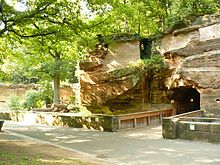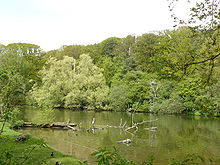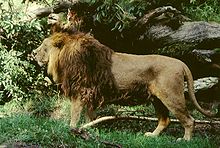- Nuremberg Zoo
-
Nuremberg Zoo (Tiergarten Nürnberg) 
Zoo entranceDate opened 11 May 1912 Location Nuremberg, Germany Land area 0.67 square kilometres (170 acres) Coordinates 49°26′51″N 11°8′41″E / 49.4475°N 11.14472°E Number of species 300 Website http://www.tiergarten.nuernberg.de www.tiergarten.nuernberg.de Nuremberg Zoo (German: Tiergarten Nürnberg) is a zoo located in the Nuremberg Reichswald ("imperial forest"), southeast of Nuremberg, Germany. With an area of 0.67 square kilometres (170 acres), approximately 300 animal species are kept by the zoo.
Contents
History
In the Middle Ages
The tradition of zoos in Nuremberg goes back to the Middle Ages. However the only indications of a zoo maintained by the local nobility, the Burgraves, take the form of certain place names, such as the Zoo Gate (Tiergärtner Tor) and the adjoining Zoo Square (Tiergärtnertorplatz). This preserve stretched as far as the so called Johannisfelder (today: St. Johannis) and the Rohlederersgarten (today the site of the Klinikum Nord). One can only speculate about the use made of the park.
20th century
The Nuremberg Zoo was founded on 11 May 1912[1] on the site of the Bavarian State Exhibition at the Luitpoldhain. After the Nazis seized power, the zoo had to give way for the Reichsparteitagsgelände at the Dutzendteich and was closed in February 1939. In May 1939, the new zoo was opened in the Reichswald at the Schmausenbuck. It was almost completely destroyed after World War II and rebuilt at the end of the 1950s.
Today
With 0.67 square kilometres (170 acres), it is one of the largest European zoos. Typical are large, natural enclosures, which are embedded in a landscape of forests and stone pits. More than one million visitors are counted every year. Many new enclosures, e.g., for gorillas, snow leopards and polar bears, were built in recent years. Flocke, a captive-born polar bear who was born at the zoo in December 2007, became a popular tourist attraction and an international celebrity after a controversial decision to remove her from her mother and raise her by hand. Flocke has since been "adopted" by United Nations Environment Programme chief Achim Steiner.[2]
Animals
The zoo has Asiatic lions and Siberian tigers, which live in former stone pits. The inner cages of both large cat species are behind a rock face and can be visited only after entering the house through a tunnel. Other carnivores are snow leopards, polar bears, Syrian brown bears, and maned wolves. The zoo is also successful in breeding cheetahs. Further attractions are Common bottlenose dolphins, Indian rhinoceroses, Malayan tapirs, lowland gorillas, California sea lions and manatis. Many hooved mammals, like reticulated giraffes, Somali wild asses, Père David's deer, European and American bison, African buffalo, plains zebras and kulans live in large enclosures, which are embedded in the forested, hilly landscape. Beautiful ponds are home to a variety of water birds.
Literature
- Dr. Peter Mühling, Der Alte Nürnberger Tiergarten 1912–1939: Eine Chronik, Tiergarten der Stadt Nürnberg, Nürnberg 1987, ISBN 3-926760-00-1
- Wegweiser durch den Tiergarten Nürnberg, 29. neubearbeitete Auflage, Tiergarten der Stadt Nürnberg, Nürnberg 2007, ISSN 1436-4352
- Lorenzo von Fersen, Delfinariumsführer Tiergarten Nürnberg, 3. Aufl., Tiergarten der Stadt Nürnberg, Nürnberg 2003, ISBN 3-926760-04-4
- Der Tiergarten Nürnberg – Ein Virtueller Rundgang, imbiss-media, Nürnberg 2002, ISBN 3-00-010598-0
- Michael Diefenbacher, Rudolf Endres (Hsg.): Stadtlexikon Nürnberg. 2. verb. Auflage. Nürnberg: Verlag W. Tümmels, 2000, 1247 S., ISBN 3-921590-69-8
References
- ^ Der alte Tiergarten
- ^ "UN environment chief becomes German polar bear cub's patron". International Herald Tribune. 2008-05-28. http://www.iht.com/articles/ap/2008/05/28/europe/EU-GEN-Germany-Polar-Bear.php. Retrieved 2008-06-11.
External links
Zoos, aquariums, and aviaries Types of zoos Conservation Lists Animals Other topics - Animals in captivity
- Animal training
- Behavioral enrichment
- Captive breeding
- Frozen zoo
- Immersion exhibit
- Nocturnal house
- Wildlife conservation
- Zookeeper
- Zoology
- Portal
- Project
- Category
- Commons
Categories:- Visitor attractions in Nuremberg
- Zoos in Germany
- Buildings and structures in Nuremberg
Wikimedia Foundation. 2010.



